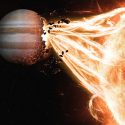The sky appears darker. The temperature is starting to drop. Our rivers are freezing, crops are covered in snow! People could go hungry.
Is it just me, or is the Sun dimming? Are we about to enter a solar minimum? Would this help fight global warming?
But wait. Why is NASA and Elon Musk so happy?
The space rumors are true, we are at the beginning of a solar minimum cycle, and NASA expects it to be one of the weakest in the last 200 years. So, what is a solar minimum, and what’s going to happen when it arrives?
To help illuminate, let’s explain what a solar cycle is. Every 11 years, give or take, the Sun goes through a cycle where the magnetic poles flip. North becomes south and south becomes north. During this period, the number of sunspots goes from low to high.
With fewer sunspots on the Sun’s surface, solar flares and activity significantly diminish. This is called a solar minimum. It potentially affects the amount of energy the Sun expels and its radiation levels. This could explain why you found yourself bundled up in your winter clothes in June a few years back.
The most extreme conditions of this happening on Earth was the “Little Ice Age” that took place between the 13th to mid-19th century. Cooling temperatures disrupted the grain harvest and created an agricultural crisis in Europe. During this time temperatures dropped by 2 °C.
NASA predicts, even when we reach the maximum level of this new cycle, it could be 30 to 50 percent weaker than the previous period. That’s leading some scientists to speculate we are entering into another “Little Ice Age” for the next few decades. Minus the Woolly Mammoths.
Now, the flip side of this solar cycle isn’t favorable either. When sunspot occurrences increase, it’s called a solar maximum.
During this time, the Sun emits highly energized particles through space that are potentially dangerous to all electronics and power grids. An extreme solar storm could wipe out power for millions, if not billions, of people on Earth.
In a flash, your phone’s not working and Netflix is cutting out. The horror. Intense solar winds could also cause GPS and telecommunications satellites to malfunction. Would you even know how to get directions without a disembodied voice telling you which way to turn? Even worse, charged particles could potentially shut down essential life-support systems, and zap the electrical functions in any spacecraft that’s home to astronauts, plummeting them to Earth.
What if the cycle permanently stopped at the next solar minimum? What if we dimmed the Sun down? Could this cool the planet enough to reverse global warming?
Well, totally understanding the Sun is still a work in progress for the scientific community. Ideas about climate change and whether solar cycles might contribute either positively or negatively are plentiful.
Unfortunately, according to NASA’s Global Climate Change team, the news isn’t really that glowing. They theorize the warming caused by human-induced greenhouse gas emissions is six times greater than the possible decades-long cooling from a prolonged solar minimum. Even if the next solar minimum were to last a century, global temperatures would still continue to warm.
So, maybe we need to start looking for Earth 2.0 after all. But what does this mean in the short term for our space aspirations and why is NASA so ‘over the moon’ happy?
Right now, NASA is working on the Artemis lunar exploration program. This will put astronauts back on the Moon by 2024. So think of using the solar cycles as predicting space weather. If you’re sending anyone or anything into space, you want the conditions to be as ideal as possible.
No surprises. Good space weather equals low levels of solar activity and radiation. If we can accurately forecast these conditions, even years ahead, we can better predict when the best time to safely send our astronauts into space might be.
With this insight, we could also safeguard and prepare humanity for the harmful effects of high solar activity. At the very least, we could secure our vulnerable power grid during this time. Continued research into the relationship we have with our Star and the rest of our solar system would be a huge help for us on Earth.
Subscribe to What-If on YouTube or follow the show on Facebook Watch.
Sources
- “How The Little Ice Age Changed History”. Lanchester, John. 2019. The New Yorker.
- “A Grand Solar Minimum Would Barely Make A Dent In Human-Caused Global Warming”. 2020. skepticalscience.com.
- “Space weather affects your daily life. It’s time to start paying attention.”. 2020. MIT Technology Review.
- “Planetary Orbits May Explain Mystery Of Sun’s 11-Year Cycle”. Rabie, Passant. 2019. space.com.
- “What influence will future solar activity changes over the 21st century have on projected global near‐surface temperature changes?”. Jones, Gareth S., Mike Lockwood, and Peter A. Stott. 2012. Journal Of Geophysical Research: Atmospheres 117 (D5): n/a-n/a. doi:10.1029/2011jd017013.
- “Impact Of A Potential 21St Century “Grand Solar Minimum” On Surface Temperatures And Stratospheric Ozone”. Anet, J. G., E. V. Rozanov, S. Muthers, T. Peter, S. Brönnimann, F. Arfeuille, and J. Beer et al. 2013. Geophysical Research Letters 40 (16): 4420-4425. doi:10.1002/grl.50806.




























From where do you get these videos